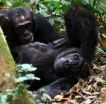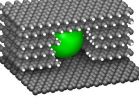(Press-News.org) This press release is available in German.
Animals which maintain cooperative relationships show gains in longevity and offspring survival. However, little is known about the cognitive or hormonal mechanisms involved in cooperation. Researchers of the Max Planck Institute for Evolutionary Anthropology in Leipzig, Germany, have now found that cooperative relationships are facilitated by an endocrinological mechanism involving the hormone oxytocin, even when these are between non-kin. They collected urine samples of 33 chimpanzees from Budongo Forest, Uganda, and measured their urinary oxytocin levels after single episodes of a specific cooperative behavior, mutual grooming. The result: Oxytocin levels were higher after grooming with cooperation partners compared with non-cooperation partners or after no grooming, regardless of genetic relatedness or sexual interest. This suggests that in chimpanzees oxytocin, which acts directly on neural reward and social memory systems, plays a key role maintaining social relations beyond genetic ties and in keeping track of social interactions with multiple individuals over time.
In non-human primates and other social animals strong and enduring social bonds are typically seen between genetically related individuals but also, occasionally, between non-kin, same-sex individuals. Although such relationships are typically defined by high rates of cooperative behaviors, how they are maintained over time is still unclear. In humans and other social mammals the neuropeptide hormone oxytocin plays a central role in facilitating bonding between kin and mating partners. Catherine Crockford, Roman Wittig and colleagues of the Max Planck Institute for Evolutionary Anthropology have now analyzed the role of this hormone in the social relationships between wild chimpanzees.
To this end the researchers observed social interactions – like mutual grooming – in a group of wild chimpanzees from Budongo Forest in Uganda and non-invasively collected urine samples of the 33 female and male adult group members on plastic bags or leaves. They determined the level of the hormone oxytocin before and shortly after the animals had been grooming with each other and found that oxytocin levels were especially high in chimpanzees who had been grooming with a "bond partner", a cooperation partner, irrespective of whether this bond partner happened to be their kin or not. On the other hand, the level of urinary oxytocin was much lower in chimpanzees who had been grooming with a "non-bond partner", with whom they did not share a cooperative relationship, or in animals who had not been grooming at all. Furthermore, the researchers found that the animal's sex or age, grooming duration and other factors did not have a significant influence on urinary oxytocin levels.
"Our results demonstrate that a rise in oxytocin was dependent upon the combined effects of social grooming with a bond partner", says Catherine Crockford of the Max Planck Institute for Evolutionary Anthropology in Leipzig, Germany. "Crucially, oxytocin levels were similarly high after grooming with non-kin and kin bond partners. This suggests that, in chimpanzees, oxytocin plays a key role in maintaining social relations beyond immediate genetic ties".
"This is the first study that measures the levels of the hormone oxytocin on wild animals in a non-invasive way", says Roman Wittig of the Max Planck Institute for Evolutionary Anthropology. "We have developed a tool with which cross-species comparisons that link underlying physiology and behavior can eventually be made of social mammals in their natural environment". In future field research this tool will be used to compare single behaviors – like other cooperative or aggressive behaviors–by measuring how they differ from each other hormonally.
INFORMATION:
Original publication
C. Crockford, R.M. Wittig, K. Langergraber, T. Ziegler, K. Zuberbühler, T. Deschner
Urinary oxytocin and social bonding in related and unrelated wild chimpanzees
Proceedings of the Royal Society B, January 23, 2013
The benefits of social grooming
Researchers found that in chimpanzees the hormone oxytocin is likely to play a key role in maintaining social relations with both kin and non-kin cooperation partners
2013-01-23
ELSE PRESS RELEASES FROM THIS DATE:
Climate change could cause massive losses in Pyrenees ski resorts
2013-01-23
An increase in temperatures due to climate change could mean that the Andorran ski resorts have a shorter season in the future, especially in lower areas. A study undertaken by the Polytechnic University of Catalonia and the Andorran Sustainability Observatory has analysed the specific case of the Pyrenean country and predicted that financial losses could come close to 50 million euros.
SINC. 22 de enero de 2013
One of the major challenges when studying climate change effects is to establish the relationship between physical impacts and environmental changes on the ...
The global gene pool of the goat is seriously under threat
2013-01-23
Amongst the range of domestic livestock species, the goat is not just the 'black sheep' but a resource of survival in impoverished countries, and many breeds are at great risk of disappearing. This is the case according to researchers of the Regional Service of Agro-Food Research and Development in their first monographic study tackling the global impact of this species.
A study from the Regional Service of Agro-Food Research and Development (SERIDA) has analysed the situation of the global goat population.
The study took into account the state of different breeds, ...
How the purple and pink sunscreens of reef corals work
2013-01-23
New research by the University of Southampton has found a mechanism as to how corals use their pink and purple hues as sunscreen to protect them against harmful sunlight.
Many reef corals need light to survive, as they benefit from sugars and lipids that are produced by their light-dependent symbiotic algae. However, in the shallow water of coral reefs, light levels are often higher than required by the corals, so paradoxically, the vital sunlight can become harmful for the algae and their hosts.
Apart from temperature, light stress is a major driver of coral bleaching ...
Santiago, Chile, will get drier and warmer
2013-01-23
This press release is available in German and Spanish.
Santiago de Chile/Leipzig. Already nowadays ten per cent or more of the population in the Metropolitan Region of Santiago de Chile is affected by extreme heat or floods. These threats will tend to increase due to the continuous expansion of the Chilean capital, the consequent changes in land use and the influences of climate change. Because of that, the international research project ClimateAdaptationSantiago (CAS) has developed, during the last three years, an Adaptation Plan to climate change for the metropolitan ...
Breakthrough: How salt stops plant growth
2013-01-23
Washington, D.C. —Until now it has not been clear how salt, a scourge to agriculture, halts the growth of the plant-root system. A team of researchers, led by the Carnegie Institution's José Dinneny and Lina Duan, found that not all types of roots are equally inhibited. They discovered that an inner layer of tissue in the branching roots that anchor the plant is sensitive to salt and activates a stress hormone, which stops root growth. The study, published in the current issue of The Plant Cell, is a boon for understanding the stress response and for developing salt-resistant ...
Reinventing retirement: New pathways, new arrangements, new meanings
2013-01-23
Retirement involves a set of institutional arrangements combined with socio-cultural meanings to sustain a distinct retirement phase in life course and career pathways. The articles outline that recent forces of change may lead to reinvention of retirement. There are factors that must be recognized as having a significant impact such as the fact that life expectancy and health status of adults over 60 has increased dramatically in recent years. Reinvention could involve change to one or more of the institutional arrangements supporting retirement. New financial risks and ...
Nanoparticles digging the world's smallest tunnels
2013-01-23
This press release is available in German.
The world's smallest tunnels have a width of a few nanometers only. Researchers from Karlsruhe Institute of Technology (KIT) and Rice University, USA, have dug such tunnels into graphite samples. This will allow structuring of the interior of materials through self-organization in the nanometer range and tailoring of nanoporous graphite for applications in medicine and battery technology. Results are now presented in the scientific journal Nature Communications (DOI: 10.1038/ncomms2399).
The tunnels are manufactured applying ...
Researchers create self-healing, stretchable wires using liquid metal
2013-01-23
Researchers from North Carolina State University have developed elastic, self-healing wires in which both the liquid-metal core and the polymer sheath reconnect at the molecular level after being severed.
"Because we're using liquid metal, these wires have excellent conductive properties," says Dr. Michael Dickey, an assistant professor of chemical and biomolecular engineering at NC State and co-author of a paper on the work. "And because the wires are also elastic and self-healing, they have a lot of potential for use in technologies that could be exposed to high-stress ...
Learn to be more understanding by watching The Bachelor (this season, anyway)
2013-01-23
A new USC study finds evidence suggesting that the brain works hard to understand those who have different bodies when watching them in action.
According to the study's lead author, the finding supports initiatives to include more individuals with physical differences in mainstream media – such as Sarah Herron, a contestant on ABC's The Bachelor this season, who was born with a foreshortened left arm.
"Generally, it's considered impolite to stare. But what these results suggest is that we need to look. It's through this visual experience that we're able to make sense ...
New way to identify 'smoked' grapes and wines
2013-01-23
With climate change sparking concern about an increased risk of wildfires, scientists are reporting development of a way to detect grapes exposed to smoke from those fires, which otherwise could be vented into bad-tasting wine. Their report on the method for detecting smoke taint in both grapes and wine appears in ACS' Journal of Agricultural and Food Chemistry.
Yoji Hayasaka and colleagues point out that Australia and other areas of the world are experiencing an increase in bush and wildfires, which may continue and intensify with global climate change. Smoke from those ...
LAST 30 PRESS RELEASES:
American College of Cardiology comments on new dietary guidelines for Americans
American Society of Gene & Cell Therapy and Orphan Therapeutics Accelerator partner to advance and commercialize promising rare disease treatments
One in 14 patients having day case surgery have new or worse chronic pain 3 months after their operation
New study highlights link between eviction rates and gun violence
Heatwaves heat up soil but not toxin levels in rice, study finds
Digital modeling reveals where construction carbon emissions really come from
Turning farm waste into water filters
New study shows how the spleen helps the immune system accept a transplant
New Mayo Clinic study advances personalized prostate cancer education with an EHR-integrated AI agent
Researchers identify novel therapeutic target to improve recovery after nerve injury
Microbes in breast milk help populate infant gut microbiomes
Reprogramming immunity to rewrite the story of Type 1 diabetes
New tool narrows the search for ideal material structures
Artificial saliva containing sugarcane protein helps protect the teeth of patients with head and neck cancer
Understanding the role of linear ubiquitination in T-tubule biogenesis
Researchers identify urban atmosphere as primary reservoir of microplastics
World’s oldest arrow poison – 60,000-year-old traces reveal early advanced hunting techniques
Bristol scientists discover early sponges were soft
New study uncovers how rice viruses manipulate plant defenses to protect insect vectors
NSF–DOE Vera C. Rubin Observatory spots record-breaking asteroid in pre-survey observations
Ribosomal engineering creates “super-probiotic” bacteria
This self-powered eye tracker harnesses energy from blinking and is as comfortable as everyday glasses
Adverse prenatal exposures linked to higher rates of mental health issues, brain changes in adolescents
Restoring mitochondria shows promise for treating chronic nerve pain
Nature study identifies a molecular switch that controls transitions between single-celled and multicellular forms
USU chemists' CRISPR discovery could lead to single diagnostic test for COVID, flu, RSV
Early hominins from Morocco reveal an African lineage near the root of Homo sapiens
Small chimps, big risks: What chimps show us about our own behavior
We finally know how the most common types of planets are created
Thirty-year risk of cardiovascular disease among healthy women according to clinical thresholds of lipoprotein(a)
[Press-News.org] The benefits of social groomingResearchers found that in chimpanzees the hormone oxytocin is likely to play a key role in maintaining social relations with both kin and non-kin cooperation partners






